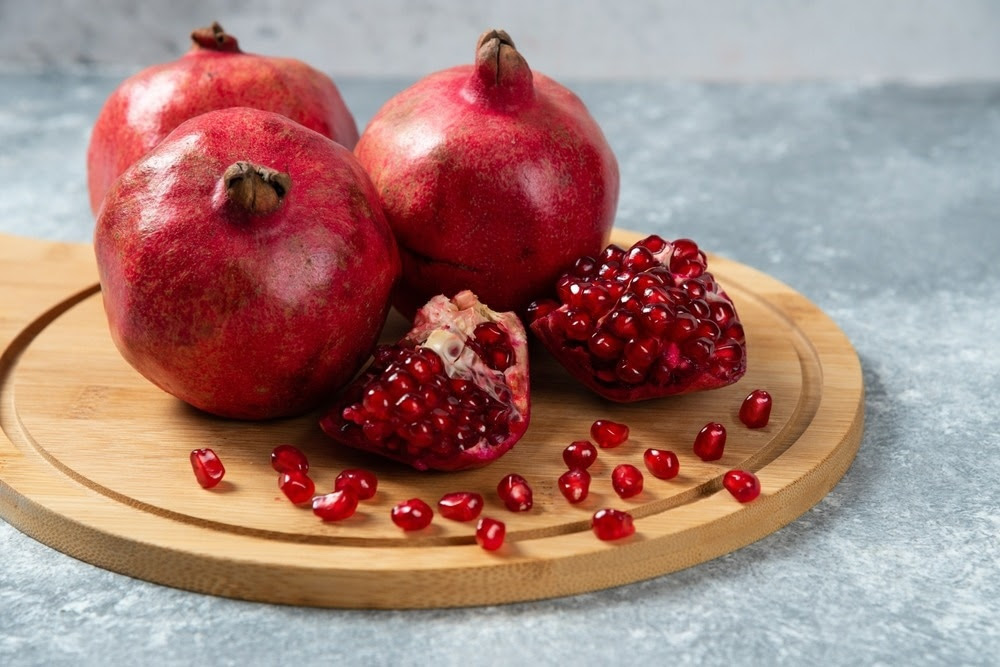By Pooja Toshniwal PahariaNov 24 2023Reviewed by Danielle Ellis, B.Sc.

In a recent review published in Nutrients, researchers reviewed existing data on the bio-modulatory effects of pomegranate (Punica granatum l., PG) polyphenols on metabolic disorders.
Study: The Modulatory Bioeffects of Pomegranate (Punica granatum L.) Polyphenols on Metabolic Disorders: Understanding Their Preventive Role against Metabolic Syndrome. Image Credit: azeraijan _stockers/Shutterstock.comStudy: The Modulatory Bioeffects of Pomegranate (Punica granatum L.) Polyphenols on Metabolic Disorders: Understanding Their Preventive Role against Metabolic Syndrome. Image Credit: azeraijan _stockers/Shutterstock.com
Background
Pomegranate, a natural nutrient, has long been used to treat bacterial infections, diabetes, obesity, and other metabolic disorders. However, there have been concerns expressed concerning the side effects of pharmacological therapies such as anti-obesity medications and insulin-sensitizing medicines. Modern research supports the health-promoting advantages of polyphenol-rich natural products and diets, including antibacterial, anti-diabetic, anti-obesity, and atheroprotective qualities.
About the review
In the present review, researchers examined the pharmacokinetic characteristics, safety, and bioavailability of PG compounds in preventing metabolic disorders such as type 2 diabetes, obesity, dyslipidemia, and cardiovascular-related diseases.
Prevention of metabolic disorders by PG consumption
PG is a plant that can reduce insulin resistance, cytokine levels, redox gene expression, blood pressure increase, vascular damage, and lipoprotein oxidative alterations. PG-ellagitannins have been demonstrated in studies to be beneficial in lowering hyperlipidemia, raising plasma high-density lipoprotein cholesterol (HDL-C), and improving total cholesterol (TC)/HDL-C and low-density lipoprotein cholesterol (LDL-C)/HDL-C ratios. Since obesity is reversible, nutritional interventions can restore metabolic equilibrium and prevent the development of obesity-related diseases.
In C57Bl/J6 mice, dietary treatment with pomegranate seed oil reduced fat mass and body weight while enhancing insulin sensitivity in peripheral tissues. These findings support prior findings of a considerable decrease in lipid indicators, including plasma TC concentration, triglyceride content, and total cholesterol/high-density lipoprotein cholesterol ratio. Lipid metabolism-associated enzymes, such as carnitine palmitoyltransferase-1 (CPT 1) and acyl-CoA oxidase (AOX), and nuclear receptors like the peroxisome proliferator-activated receptor-alpha (PPAR-α) favorably affect PG floral components.
Studies have reported weight reductions after consuming PG extracts for 30 days. However, contradicting results concerning food intake and gain in weight have been documented. The reported discrepancies may be explained by altered physiologic responses to phytochemicals resulting from genetic variances.
Traditional medicine is considering PG polyphenols for their anti-diabetic properties. PG may exert its effects via a variety of mechanisms, including PPAR-γ activity modulation, protein degradation resistance, adiponectin gene expression, inhibition of β-glucosidase enzymatic activities, glucose transporter protein type-4 (Glut-4) messenger ribonucleic acid (mRNA) expression, and β-mass regeneration.
Short-term therapy with PG peel extract can lower α-amylase activity, blood glucose levels, and lipid peroxidation. Studies have indicated that PG intake can improve plasma HDL-C concentrations in hyperlipidemia patients and control lipid parameters in dyslipidemic individuals with type 2 diabetes.
Pharmacokinetics, pharmacodynamics, and safety of ellagitannin constituents of PG compounds
Punicic acid, a PG compound, has been found to have potential health advantages. Several factors, including the physicochemical properties of the molecules and individual-specific factors, including microbiota makeup and gut pH, regulate the bioavailability and absorption capacities of the compound. The ability of urolithins to produce and absorb urolithins varies greatly, with punicalagin being detected at a maximum concentration (C-max) of 30 g/mL in rats fed a diet containing six percent punicalagin.
In body tissues, urolithin accumulates in the colon and prostate, with a restricted ability to reach organs such as the liver and kidney. The biochemical qualities of organ cells, such as their selective properties and permeability, the overall structure of the ellagitannins (ET) molecule, and individual variances in blood transport efficiency, may all impact the dispersion and deposition capacities of PG ellagitannins.
Although traditional medicine literature supports the use of PG and its potential to improve health outcomes, several toxicological studies have revealed cellular component modification and nuclear damage following PG administration.
In vitro and in vivo toxicological studies of PG seed oil, a high source of punicic acid, found that it is neither mutagenic nor clastogenic. The post-mortem examinations revealed no cellular abnormalities, and 4.3 g/kg/day of PG intake produced no harm. The use of PG or pure PG compounds appears safe, with adverse effects predicted at dosages far higher than those seen in traditional ethnomedicine treatments and now employed for therapeutic purposes.
Conclusion
Overall, the review findings showed that PG consumption may help prevent metabolic disorders such as hyperglycemia and hyperlipidemia; however, clinical and pharmacokinetic studies are inconsistent due to factors like plant part selection, cultivar, geographical region, bioclimatic and soil characteristics, plasma bioavailability, organ accessibility, and nutrigenomics considerations. Irrespective of these variations, the medicinal efficacy of PG in treating metabolic syndrome components necessitates multifaceted treatment approaches.

Leave a Reply